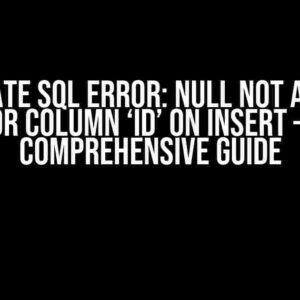Are you ready to take your Quarkus application to the next level with Couchbase? In this comprehensive guide, we’ll walk you through the step-by-step process of setting up Couchbase with Quarkus. Buckle up, folks!
- What is Couchbase?
- What is Quarkus?
- Prerequisites
- Step 1: Create a New Quarkus Project
- Step 2: Add the Couchbase Extension
- Step 3: Configure Couchbase
- Step 4: Create a Couchbase Configuration Class
- Step 5: Create a Couchbase Repository
- Step 6: Create a Quarkus Resource
- Step 7: Run the Application
- Conclusion
What is Couchbase?
Couchbase is a NoSQL, document-oriented database that’s designed for modern applications. It’s a powerful tool for storing and managing large amounts of data, and it’s particularly well-suited for real-time web and mobile applications. With Couchbase, you can scale your database effortlessly, ensure high performance, and enjoy a flexible data model.
What is Quarkus?
Quarkus is a Kubernetes-native Java framework that’s designed to make building cloud-native applications a breeze. It’s a modern, lightweight alternative to traditional Java frameworks, and it’s optimized for GraalVM and HotSpot. With Quarkus, you can create fast, efficient, and scalable applications that are perfect for containerized environments.
Prerequisites
Before we dive into the setup process, make sure you have the following installed on your system:
- Java 11 or later
- Maven 3.6.0 or later
- Couchbase Server 6.5.1 or later
- Quarkus 1.7.0 or later
Step 1: Create a New Quarkus Project
Let’s start by creating a new Quarkus project. Open your terminal and run the following command:
mvn io.quarkus:quarkus-maven-plugin:1.7.0:create \
-DprojectGroupId=com.example \
-DprojectArtifactId=couchbase-quarkus \
-DprojectVersion=1.0-SNAPSHOTThis will create a new Quarkus project with the specified group ID, artifact ID, and version.
Step 2: Add the Couchbase Extension
Next, we need to add the Couchbase extension to our Quarkus project. Run the following command:
mvn quarkus:add-extension -Dextensions="couchbase"This will add the Couchbase extension to your project’s pom.xml file.
Step 3: Configure Couchbase
Now, we need to configure Couchbase to connect to our Quarkus application. Create a new file called `couchbase.properties` in the `src/main/resources` directory:
couchbase.uri=http://localhost:8091
couchbase.username=Administrator
couchbase.password=password
couchbase.bucket=defaultUpdate the values to match your Couchbase Server installation.
Step 4: Create a Couchbase Configuration Class
Create a new Java class called `CouchbaseConfig` in the `com.example` package:
@Singleton
public class CouchbaseConfig {
@Inject
private CouchbaseProperties properties;
@Produces
@Singleton
public Cluster createCluster() {
return Cluster.connect(properties.getUri(), ClusterOptions.clusterOptions(properties.getUsername(), properties.getPassword()));
}
@Produces
@Singleton
public Bucket createBucket(@Inject Cluster cluster) {
return cluster.bucket(properties.getBucket());
}
}
This class creates a Couchbase cluster and bucket using the values from the `couchbase.properties` file.
Step 5: Create a Couchbase Repository
Create a new Java interface called `CouchbaseRepository` in the `com.example` package:
@Repository
public interface CouchbaseRepository {
@Query("SELECT * FROM `default` WHERE type = 'user'")
List< JsonObject > getUsers();
@Query("INSERT INTO `default` (type, name, email) VALUES ('user', $1, $2) RETURNING *")
JsonObject createUser(String name, String email);
}
This interface defines two methods: `getUsers()` and `createUser()`. These methods will be used to interact with our Couchbase bucket.
Step 6: Create a Quarkus Resource
Create a new Java class called `CouchbaseResource` in the `com.example` package:
@Path("/api")
public class CouchbaseResource {
@Inject
private CouchbaseRepository repository;
@GET
@Produces(MediaType.APPLICATION_JSON)
public List<JsonObject> getUsers() {
return repository.getUsers();
}
@POST
@Consumes(MediaType.APPLICATION_JSON)
@Produces(MediaType.APPLICATION_JSON)
public JsonObject createUser(User user) {
return repository.createUser(user.getName(), user.getEmail());
}
}
This class defines a Quarkus resource that exposes two endpoints: `GET /api` and `POST /api`. These endpoints will be used to interact with our Couchbase repository.
Step 7: Run the Application
Finally, let’s run our Quarkus application. Open your terminal and run the following command:
mvn quarkus:devThis will start the Quarkus development mode. You can now access your application at `http://localhost:8080/api`.
Conclusion
In this article, we’ve covered the step-by-step process of setting up Couchbase with Quarkus. We’ve created a new Quarkus project, added the Couchbase extension, configured Couchbase, created a Couchbase configuration class, created a Couchbase repository, created a Quarkus resource, and run the application. With this setup, you’re now ready to start building your next-generation application with Couchbase and Quarkus.
Troubleshooting Tips
If you encounter any issues during the setup process, here are some troubleshooting tips to help you out:
| Error | Solution |
|---|---|
| Couchbase extension not found | Check that you’ve added the correct extension to your pom.xml file. |
| Couchbase configuration issues | Verify that your couchbase.properties file is correctly configured. |
| Cluster connection issues | Check that your Couchbase Server is running and accessible. |
| Bucket creation issues | Verify that your bucket name is correct and exists in your Couchbase Server. |
Next Steps
Now that you’ve set up Couchbase with Quarkus, here are some next steps to consider:
- Explore Couchbase’s advanced features, such as indexing and querying.
- Integrate Couchbase with other Quarkus extensions, such as Hibernate or RESTEasy.
- Build a more complex application that leverages Couchbase’s scalability and performance.
Happy coding!
Here are 5 Questions and Answers about “How to setup Couchbase with Quarkus?” in HTML format:
Frequently Asked Question
Get ready to dive into the world of NoSQL databases with Couchbase and Quarkus! Here are some frequently asked questions to get you started.
What do I need to set up Couchbase with Quarkus?
To set up Couchbase with Quarkus, you’ll need to have Couchbase Server installed and running on your machine. You’ll also need to add the Couchbase extension to your Quarkus project by adding the following dependency to your `pom.xml` file: `
How do I configure the Couchbase connection in Quarkus?
To configure the Couchbase connection in Quarkus, you’ll need to add the following configuration properties to your `application.properties` or `application.yml` file: `quarkus.couchbase.uri`, `quarkus.couchbase.username`, and `quarkus.couchbase.password`. For example: `quarkus.couchbase.uri=couchbase://localhost:8091`, `quarkus.couchbase.username=myusername`, and `quarkus.couchbase.password=mypassword`. You can also specify additional configuration options, such as the bucket name and timeout settings.
How do I inject the Couchbase Bucket in my Quarkus service?
To inject the Couchbase Bucket in your Quarkus service, you can use the `@Inject` annotation along with the `CouchbaseBucket` interface. For example: `@Inject CouchbaseBucket bucket;`. This will give you access to the Couchbase Bucket instance, which you can use to perform CRUD operations and other database interactions.
Can I use Couchbase transactions with Quarkus?
Yes, you can use Couchbase transactions with Quarkus! Quarkus provides integration with Couchbase’s transactional API, allowing you to perform atomic operations and ensure consistency across multiple documents. To use transactions, you’ll need to enable the transactional behavior in your Quarkus configuration and use the `CouchbaseTransaction` interface to perform transactions.
Is it possible to monitor and debug my Couchbase-based Quarkus application?
Yes, you can monitor and debug your Couchbase-based Quarkus application using various tools and techniques! Quarkus provides built-in support for metrics and tracing, allowing you to monitor performance and debug issues. You can also use Couchbase’s built-in monitoring and debugging tools, such as the Couchbase Server UI and the Couchbase Java SDK’s built-in logging and tracing capabilities.



